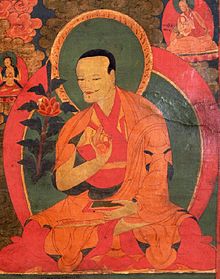
Back গো-রাম্স-পা-ব্সোদ-নাম্স-সেং-গে Bengali/Bangla Gorampa Sönam Sengge German Gorampa French Gorampa Sönam Senge NB

Gorampa Sonam Senge (Wylie: go rams pa bsod nams seng ge, 1429–1489[1]) was an important philosopher in the Sakya school of Tibetan Buddhism. He was the author of a vast collection of commentaries on sutra and tantra whose work was influential throughout Tibetan Buddhism. Gorampa is particularly known for his writings on madhyamaka philosophy, especially his critique of the madhyamaka views of Tsongkhapa and Dolpopa. Gorampa defended the mainly anti-realist interpretation of madhyamaka held by the Sakya school (which sees conventional truth as a false illusion).[2]
Gorampa was the student of Rongtön (Rongtön Shéja Künrig, Wylie: rong ston shes bya kun rig), Byams chen rab ’byams pa Sangs rgyas ’phel (1411–85), Ngor chen Kun dga’ bzang po (1382–1456), Gung ru Shes rab bzang po (1411–75).[1][3] He founded the Thuptén Namgyél Monastery in Tanag (Wylie: rta nag thub bstan rnam rgyal gling), which is just north of Shigatse.
Gorampa's works were very influential in Sakya and also outside of the Sakya school. He was a major rival which Gelug scholastics responded to centuries after his death. His work was also a major source for the madhyamaka views of Mipham (1846–1912).[4] His works were suppressed by Gelug state institutions for his polemical treatment of Tsongkhapa's views. In the 20th century, they were re-published by Jamgyal Rinpoche with permission from the 13th Dalai Lama. His work is widely studied today in Sakya, Kagyu and Nyingma scholasticism.[5]
- ^ a b Dreyfus (2003) p.301
- ^ Dreyfus, Georges B. J. (1997) Recognizing Reality: Dharmakirti's Philosophy and Its Tibetan Interpretations (Suny Series in Buddhist Studies), p. 2.
- ^ Cabezón & Dargyay (2007), pp. 34–36.
- ^ Cabezón & Dargyay (2007), pp. 55–56
- ^ Kassor, Constance, "Gorampa [go rams pa]", The Stanford Encyclopedia of Philosophy (Winter 2017 Edition), Edward N. Zalta (ed.).